By Philip Joe Cauchi
Introduction: In this session we are going to raise the players’ bar in dealing with 1v1 defending situations starting from different positions. This will develop the players’ mental abilities to quickly recognise how their position should be in relation to the ball and the goal they are defending. From these situations we will move on to collaborative defending in pairs. Situations in this setup involve having the second defender recovering back at speed to cover the first defender. The session ends in a game where individual and small group principles of defending are applied to the global game.
Session number: 2 of 8.
Total duration: 80 minutes.
Moment of play: Opponents in possession.
Team task: Prevent scoring.
Theme: Defending to win the ball.
Main aim: Prevent the opponents from scoring.
Outcomes:
1. Block the attacker’s route to the goal.
2. Block shots on target.
3. Force attacker (ball-carrier) away from goal and into tighter angles.
4. Angles and distances between the defending pair to reduce playing time and space for the attackers and to increase the chances of the defenders to win the ball.
5. Recognise who of the defensive pair are in the best position to attack the ball, while the other provides cover.
6. Recognise moments to double team opponent to cut off his playing options and win the ball.
7. Timing of tackles to win the ball.
8. Initiate a counter attack immediately after winning the ball.
Activation: 4v2 with target players.
Targeted outcomes: 1, 4, 5, 6 and 7.
Duration: 15 minutes.
Players: Three groups of six players each.
Area: 15 yards by 12 yards.
Description: Start by having the players work on their ball mastery skills on their own for five minutes. This should be followed by two minutes of dynamic stretching and mobility exercises. Following this we move to the activity shown hereunder. The attacking players (blacks) aim to play the ball from one target player to the other while the defenders aim to intercept the ball and dribble it out of the area. Play for forty seconds and then rotate the two defenders.
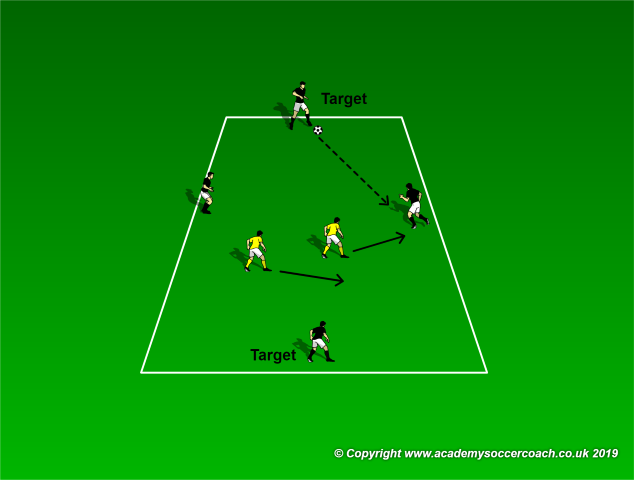
Questions to engage the defending players in their learning process:
How should our shape be when one of the target players has the ball? Compact and central.
What should our movements be when the ball is passed to one of the lateral players? Closest defender applies pressure to not allow the attacker to play forward to the opposite target player, while the other defender provides cover.
Individual training situation: Defend your line and counter.
Targeted outcomes: 1, 3, 7 and 8.
Duration: 10 minutes – 2 x 4 minutes interspersed with two minutes of rest.
Players: Two groups of attackers and a group of defenders. Have two setups playing at the same time so to enable players to have lots of repetitions.
Area: 15 yards in length by 10 yards in width.
Description: This training situation is repeated from the previous session. The reason being that through the session we want to take the players from familiar situations to unknown ones, thus increasing their learning bar. Throughout this process we will be guiding them by providing different stimuli and challenges.
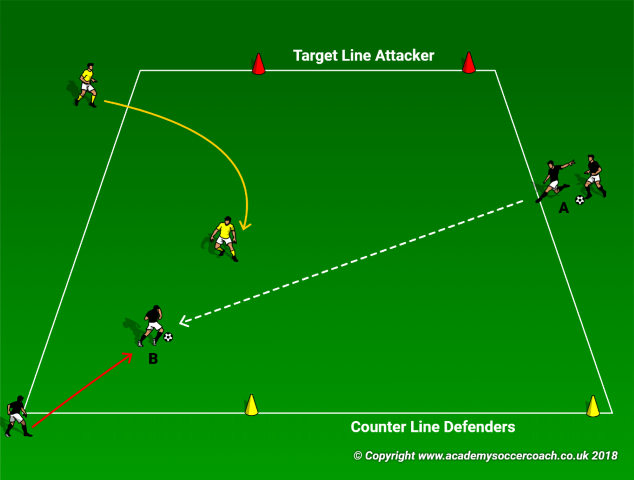
Analyse and discuss the following with the players:
Timing of applying pressure on the ball – as soon as the ball is played by player A.
Angle of approach – at an angle, forcing the ball-carrier towards the outside.
Defensive stance – side-on and low on the knees.
Timing of tackles – bad touch on the ball, at the moment the attacker is trying to turn, when the attacker has no space to dribble, etc.
Individual game-specific training situation: 1v1 from the side.
Targeted outcomes: 1, 2, 3, 7 and 8.
Duration: 10 minutes – 2 x 4 minutes interspersed with two minutes of rest.
Players: Have two setups with each consisting of four attackers, four defenders and a goalkeeper in goal.
Area: 20 yards in length by 15 yards in width.
Description: The attacker starts dribbling from the side while being pressured by the defender. The defender aims to stop the attacker from scoring, win the ball and counter on the two mini goals. Experiment with the area, such as making it smaller, narrower, longer, etc. Put the defenders in different defending conditions. Let them learn through their own experience and from their own mistakes. Repeat the same exercise from a different perspective, starting from the opposite side. Now the defender has to defend with the goal behind and to his right side.
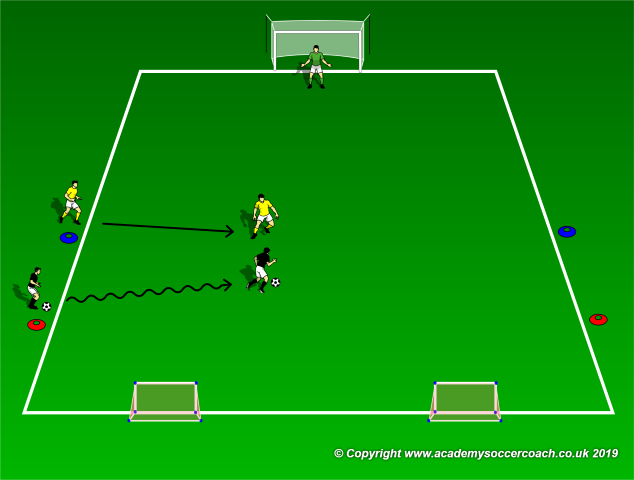
Assess and discuss the following with the players:
Is the defender focused on the ball or on the movement of the attacker’s legs? Focus should be on the ball.
Is the defender trying to block the attacker’s dominant leg? Force attacker onto his weaker foot thus reducing his playing ability and options.
Small group game-specific training situation: 2v2 with insertion of the second attacker and a recovering defender.
Targeted outcomes: All.
Duration: 15 minutes – 4 x 2 minutes interspersed with two minutes of rest.
Players: Have two setups with each setup consisting of four attackers, four defenders and a goalkeeper in goal.
Area: 20 yards in length by 15 yards in width.
Description: Attacker A1 starts dribbling the ball while being tracked by defender D1. Second attacker A2 inserts himself in attack, while the second defender D2 recovers back to cover and support first defender D1. The defenders must work together to prevent the attackers from scoring, aim to win the ball and counter on the two mini goals.
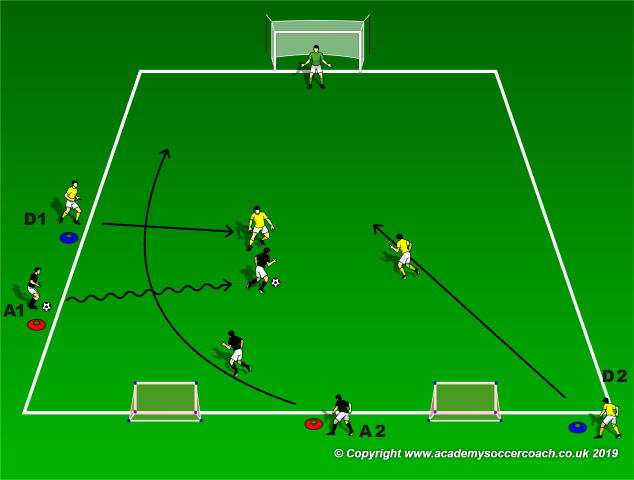
Assess the following and discuss with the players:
What is the first defender (D1)’s job till the second defender gets into covering position? Delay the forward movement of the attackers and cut-off shooting opportunities.
If the first attacker (A1) dribbles to the side of the second defender (D2), how should the two defenders’ position be? D2 applies pressure while D1 drops to cover and also track A2 if the latter performes an overlap as shown in the above diagram.
Small sided game: 4v4+GK with counter goals.
Targeted outcomes: All.
Duration: 20 minutes – 4 x 3 minutes interspersed with two minutes of rest.
Players: One team consists of a goalkeeper and four outfield players (yellows) and the other team of four outfield players (blacks).
Area: 40 yards by 30 yards.
Description: The attacking team (blacks) aim to score in the regular goal defended by the yellow team and defend the two mini goals positioned on the opposite end. There are no corner kicks or throw-ins. The team in possession restarts play from their own goal line. The defending team (yellows) can only score from inside the scoring zone. This is a constraint put into action to develop the defending team’s ability to construct an attack immediately after winning possession. Teams change roles after three minutes of continuous uninterrupted play.
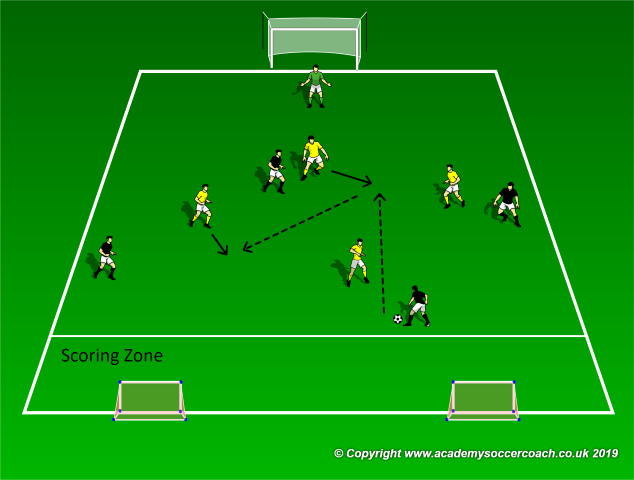
Work on the following with the players:
Defending shape. Compactness – distances and angles.
Overload ball zone to reduce the attacking team’s playing options.
Conclusive part.
Duration: 10 minutes.
Spend five minutes from the conclusive part by having players passing the ball in pairs. End the session with a brief Q and A with the players. Ask them questions that will elicit their imagination to think of specific situations in which the key outcomes of the session could be applied.
Philip Joe Cauchi works as performance coach in Malta. He holds a UEFA A and a UEFA A Youth Elite coaching licences as well as a B.ed (Hons) in Education with Physical Education and is also a qualified football conditioning coach.


